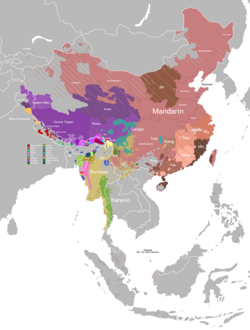Tibetic language spoken in China, Bhutan and India
| Groma | |
|---|---|
| Tromowa | |
| Native to | China, Bhutan and India |
| Region | Chumbi Valley region between Sikkim and Bhutan |
Native speakers | (27,000 cited 1993–2007)[1] |
| Language codes | |
| ISO 639-3 | gro |
| Glottolog | grom1238 |
Groma, also known as Tromowa and J'umowa, is a language spoken primarily in the lower Chumbi Valley in Tibet, with some speakers in Sikkim in India.[2] It belongs to the southern group of Tibetan languages. Its speakers identify as Tibetans.
References
[edit]- ^ Groma at Ethnologue (25th ed., 2022)

- ^ van Driem, George (2015), "Endangered Languages of South Asia", in Matthias Brenzinger (ed.), Language Diversity Endangered, Walter de Gruyter GmbH & Co KG, p. 312, ISBN 9783110905694
Further reading
[edit]- Hattaway, Paul (2004), "Groma", Peoples of the Buddhist World: A Christian Prayer Diary, William Carey Library, pp. 68–69, ISBN 9780878083619
Sino-Tibetan branches | |||||
|---|---|---|---|---|---|
| Western Himalayas (Himachal, Uttarakhand, Nepal, Sikkim) |
| ||||
| Eastern Himalayas (Tibet, Bhutan, Arunachal) | |||||
| Myanmar and Indo- Burmese border |
| ||||
| East and Southeast Asia |
| ||||
| Dubious (possible isolates, Arunachal) |
| ||||
| Proposed groupings | |||||
| Proto-languages | |||||
Italics indicates single languages that are also considered to be separate branches. | |||||
| West Himalayish (Kanauric) |
| ||||||||||||||||||||||||||||
|---|---|---|---|---|---|---|---|---|---|---|---|---|---|---|---|---|---|---|---|---|---|---|---|---|---|---|---|---|---|
| Bodish |
| ||||||||||||||||||||||||||||
| Tamangic |
| ||||||||||||||||||||||||||||
| Official | |||||||||||||||||||||||||||||||||||||||||||||||||||||||||
|---|---|---|---|---|---|---|---|---|---|---|---|---|---|---|---|---|---|---|---|---|---|---|---|---|---|---|---|---|---|---|---|---|---|---|---|---|---|---|---|---|---|---|---|---|---|---|---|---|---|---|---|---|---|---|---|---|---|
| Regional |
| ||||||||||||||||||||||||||||||||||||||||||||||||||||||||
| Indigenous |
| ||||||||||||||||||||||||||||||||||||||||||||||||||||||||
| Minority | |||||||||||||||||||||||||||||||||||||||||||||||||||||||||
| Varieties of Chinese | |||||||||||||||||||||||||||||||||||||||||||||||||||||||||
| Creole/Mixed | |||||||||||||||||||||||||||||||||||||||||||||||||||||||||
| Extinct | |||||||||||||||||||||||||||||||||||||||||||||||||||||||||
| Sign | |||||||||||||||||||||||||||||||||||||||||||||||||||||||||
| |||||||||||||||||||||||||||||||||||||||||||||||||||||||||
This article about the culture of India is a stub. You can help Wikipedia by expanding it. |
This Sino-Tibetan languages-related article is a stub. You can help Wikipedia by expanding it. |
